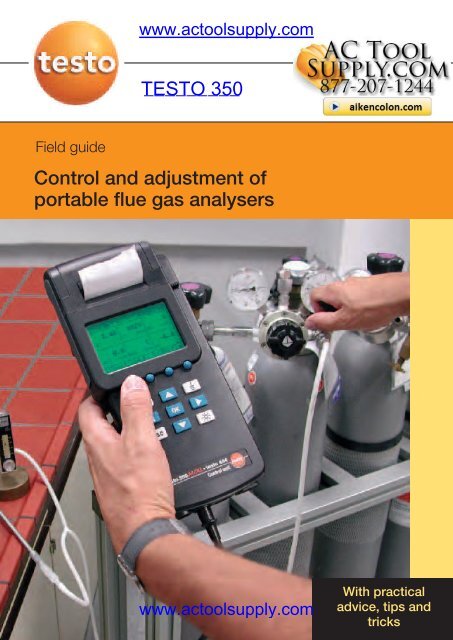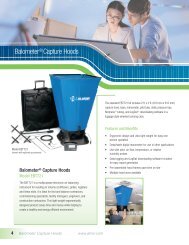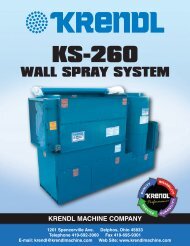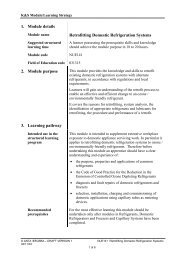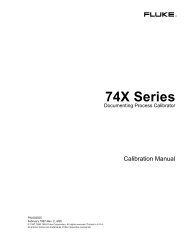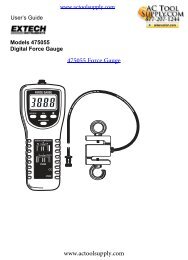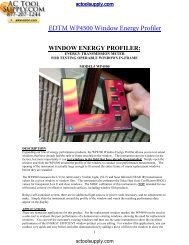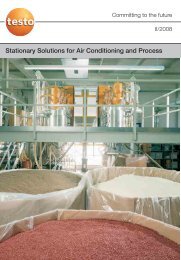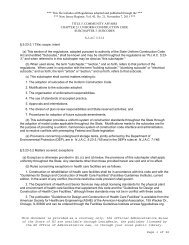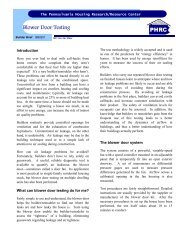Testo 350 Calibration - Actoolsupply.com
Testo 350 Calibration - Actoolsupply.com
Testo 350 Calibration - Actoolsupply.com
- No tags were found...
You also want an ePaper? Increase the reach of your titles
YUMPU automatically turns print PDFs into web optimized ePapers that Google loves.
www.actoolsupply.<strong>com</strong>Field guideControl and adjustment ofportable flue gas analyserswww.actoolsupply.<strong>com</strong>With practicaladvice, tips andtricks
www.actoolsupply.<strong>com</strong>IntroductionThis guide is intended for users of <strong>Testo</strong> flue gas analysers who areresponsible for their control and adjustment by means of test gaseson the basis of particular requirements in respect of quality oraccuracy.It contains all the answers to questions which have cropped up onthis subject at <strong>Testo</strong> over the course of time.For those users who do not wish to explore this subject in greaterdepth, <strong>Testo</strong> offers a regular control and adjustment service (includingcalibration protocol) almost anywhere in the world.This guide will help users decide which type of control they shouldchoose.It also offers information that would go far beyond the scope of theoperating instructions for analysers.What is missing? What has not been dealt with intensively enough?We wel<strong>com</strong>e your ideas, amendments and suggestions for howthis guide can be improved. They will be considered in the nextissue.The Board of DirectorsBurkart Knospe Wolfgang Hessler Martin Schulzwww.actoolsupply.<strong>com</strong>3
www.actoolsupply.<strong>com</strong>4www.actoolsupply.<strong>com</strong>
www.actoolsupply.<strong>com</strong>Table of contentsChap.Contents..............................................................Page1 Definition of termse.g. calibration/adjustment/alignment/inspection/zero point etc.......................................62 The principles of test gasAdvice from manufacturers of test gases, ppm/vpm/mgr/m³, safety advice,websites, test gas <strong>com</strong>binations ..........................83 Hardware for adjustment (material, design)Gas admission - notes..........................................134 Adjustment/alignment4.1 Factory adjustment of <strong>Testo</strong>flue gas analysers ........................................164.2 Adjustment/readjustment of <strong>Testo</strong> units/options for the customer..............................194.3 Adjustment intervals ....................................204.4 Re<strong>com</strong>mended gas concentrations ............214.5 Cross-sensitivity ..........................................235 Step-by-step example........................................256 Troubleshooting ..................................................287 <strong>Testo</strong> flue gas analysersOverview ..............................................................30Heating ................................................................31Industry ................................................................368 Index....................................................................449 <strong>Testo</strong> addresses..................................................46Requesting information ......................................54www.actoolsupply.<strong>com</strong>5
www.actoolsupply.<strong>com</strong>1. Definition of terms<strong>Calibration</strong>The determination, under prescribed conditions, of the mutualassociation between the indication of the analyser on the one handand the relevant values of a variable (in this case test gas) representedas a measurement standard on the other. Result of a calibration:Error of measurement.Adjustment or alignmentElimination of the falsifying systematic error of measurement for theintended application, e.g. readjustment with test gas in the event ofdeteriorating sensor sensitivity.StandardisationThe standardisation of a measuring device <strong>com</strong>prises the qualityinspections and identification markings to be carried out in accordancewith standardisation regulations (e.g. standardisation laws,regulations on weights and measures). It is in actual fact impossibleto standardise a flue gas analyser.Error of measurement (accuracy)Indicated measurement minus the true value of the measured variable.This can be represented in a variety of ways:• relative deviation from the measured value• deviation relative to the limit value of the measuring range• absolute indication, for instance as vol. % or ppm.Reproducibility (repeat accuracy)Standard deviation of a series of measured values from measurementsperformed at short intervals of time and carried out accordingto a defined measurement procedure by the same operator onthe same parts, using the same equipment and at the same place.LinearityDeviation from the correct values of the measured values displayedacross a measuring range.6www.actoolsupply.<strong>com</strong>
www.actoolsupply.<strong>com</strong>Zero pointWhat the sensor signal unit displays in the absence of the gas tobe verified (= “target gas”).Slope/sensitivitySensor signal per admitted (unit of) concentration. This is determinedin adjustment, calibration and is stored for later measurements.Measuring rangeThis is the concentration range in which the target gas can bemeasured by the sensor/unit with the specified accuracy.Cross-sensitivityThe characteristic of sensors to react not only to the target gas tobe verified, but also to other gases.Response timePeriod of time the sensor/unit needs in order to react to the introducedconcentration with a stable signal/indication. In practice, t xytimes are given, e.g. T 90time. This is the length of time until90 % of the introduced concentration is displayed.OxidationThe <strong>com</strong>bination of elements with oxygen. In gases, for instance,the oxidation of NO produces NO 2.AbsorptionThis is understood to mean the penetration of gases or gas mixturesinto liquids or solid substances. NO 2, for instance, isabsorbed/fixed by rubber or silicone hoses.AdsorptionAdsorption takes place if gases are held solely by the surfaceforces when they <strong>com</strong>e into contact with a solid substance, e.g.the inside wall of a hose. These “captured” gases are then given offagain uncontrolledly (e.g. the presence of NO 2is indicated eventhough no more NO 2gas is applied).www.actoolsupply.<strong>com</strong>7
www.actoolsupply.<strong>com</strong>2. The principles of test gasesTest gases are used for the calibration and adjustment of flue gasanalysers. Different gas mixtures are required according to thedevice, the configuration and the sensors.Gas mixtures:Gas mixtures are homogeneous mixtures of different types ofatoms and molecules. A large number of gases and possible <strong>com</strong>binationsare available. However, the production of gas mixtures isconstrained by the physical and chemical properties of the <strong>com</strong>ponentsand by aspects to do with safety.The effects (cross-sensitivity) on other sensors in a fully-configuredanalyser with 5 or 6 sensors result from the use of several bottleswith single concentrations (e.g. 100 ppm NO, residual N 2).Components:The gas constituents CO, O 2, N 2etc. of a mixture are known as the<strong>com</strong>ponents. Information on them can be found on the analysiscertificate.Carrier gas/basic gas:This gas is the main constituent of the mixture. The main carriergas used is nitrogen (N 2) or synthetic air.Indication of content/concentration:The amount of substance that does not depend on pressure andtemperature. The <strong>com</strong>mon units are ppm (parts per million) or %(parts per 100). Conversion: 1 % = 10,000 ppm.Other <strong>com</strong>mon indications are the volume vpm (volume per million)or mass kg/m 3 . However, these are dependent on pressure andtemperature and require the indication of the standard operatingconditions, for instance the standard conditions of temperature0 °C = 273.15 K and pressure = 1.013 hPa.8www.actoolsupply.<strong>com</strong>
www.actoolsupply.<strong>com</strong>In practice, many mixtures can be regarded more or less as a mixtureof ideal gases in which the same amount of substance of therespective <strong>com</strong>ponents takes up the same volume. This meansthat the amount of substance in ppm and the volume in vpm areequivalent in this approximation.Accuracy of test gas/certificate:Test gases can be obtained in a variety of accuracy classes. Theachievable precision depends on the type and the content of thedesired <strong>com</strong>ponents.For analysers, the test gas used usually has an analysis tolerance (doesnot correspond to the manufacturer’s tolerance) of 2 % of the measuredvalue.For the purposes of traceability, it is important that test gases witha manufacturer’s certificate are used.Information on the analysis certificate:- Production toleranceThis is the maximum permitted deviation of a <strong>com</strong>ponent (actualvalue) from the prescribed target value in the manufacture ofthe gas mixture.- Analysis toleranceAfter the mixture has been produced, the exact <strong>com</strong>position isdetermined with restorative methods of analysis. The analysistolerance gives the maximum deviation of the measured valueindicated on the certificate from the true value of a <strong>com</strong>ponent.- Stability and period of useDepending on their type, gas mixtures cannot be stored andused indefinitely. This “use by” date must be indicated on theanalysis certificate. Two years is typical for standard gas mixtures.- Filling pressure and minimum pressure of useThe filling pressure corresponds to the bottle pressure of a newbottle at the reference temperature. The minimum pressure ofuse must not be underused because stable concentrations areno longer guaranteed.www.actoolsupply.<strong>com</strong>9
www.actoolsupply.<strong>com</strong>- Storage temperatureThe storage temperature should be observed in order to preventthe gas mixture from changing over time and to avoidadsorption effects if temperatures are too low.Test gas containers:Test gases are available in pressurised gas cylinder bottles fromspecialist gas manufacturers. In Europe the standard bottle sizeshave volumes of 50, 40, 10 and 2 litres.These bottles are bought on a rental/money-back basis. Smalleraluminium bottles are also available. See <strong>Testo</strong>’s calibration bottles.The typical standard filling pressure of the larger steel bottles isabout 150 or 200 bar. In a 10-litre bottle, this means a useful volumeof 1500 litres of gas.For portable flue gas analysers with a flow rate of 1.0 to 1.2 l/min,it is assumed that 5 to 6 litres of gas will be required per calibration/adjustment(for each sensor) in the case of single gases.For the above 10-litre bottle, this is enough for about 300 controls/adjustments.When determining the optimal bottle size, itmust also be remembered that the maximum period of use of thetest gas is around 2 years. The test gases should definitely not beused any more after 2 years, regardless of how much is left in thebottle.Test gas <strong>com</strong>bination - multiple or single gases?A single gas is taken to mean a gas mixture of the mixed substanceand a carrier gas (residual gas). Example: 300 ppm CO,residual nitrogen (N 2).Multiple gases contain more than one of the desired <strong>com</strong>ponents(maximum 4). However, it must be remembered that not all <strong>com</strong>binationsare possible.Multiple gases are also normally more expensive, and some ofthem have a shorter period of use. The advantage of multiple gasesis the reduction in the number of bottles and thus simpler handling.Re<strong>com</strong>mendation: Manufacturers hold standard <strong>com</strong>-10www.actoolsupply.<strong>com</strong>
www.actoolsupply.<strong>com</strong>binations (mixes) in stock. These standard concentrations shouldbe preferred in the event of purchase.If using multiple gases, it is also important to note any cross-sensitivitiesof gas sensors (see Point 4.5). Example: An SO 2sensor withNO 2cross-sensitivity cannot be adjusted using mixed gas containingNO 2.Safety advice for handling test gases:Operations with test gases demand particular attention with regardto safety. Please refer to TRGS 280 (Operation of pressurised gasvessels).Important safety aspects - an overview (not <strong>com</strong>plete):- Gas bottles must always be protected against falling over, e.g.by means of chains or belts.- Test gas bottles must only be stored and used in well-ventilatedrooms or under venting. Danger of poisoning.The maximum working concentration and its short-time value mustnot be exceeded.Gas Threshold Short-time Short-timelimit value value value durationCO 30 ppm 60 ppm 30 minCO 25 000 ppm 1 % 60 minNO 5 ppm 10 ppm 5 minNO 25 ppm 10 ppm 5 minSO 22 ppm 4 ppm 5 minNH <strong>350</strong> ppm 100 ppm 5 minH 2S 10 ppm 20 ppm 10 minwww.actoolsupply.<strong>com</strong>11
www.actoolsupply.<strong>com</strong>- With explosive gases, note the explosion limit:methane 5 %, propane 2.1 % and hexane 1 %.- Additional regulations must be observed when transporting(e.g. by car, aircraft etc.).12www.actoolsupply.<strong>com</strong>
www.actoolsupply.<strong>com</strong>3. Hardware for adjustmentand control (material <strong>com</strong>position)The materials in the hardware that is used must satisfy the followingcriteria:The pressure reducer fittings and pipes to and from the gas bottlesshould be made of stainless steel (reason: aggressive, corrosivegases). In the case of bottles with a brass outer thread (e.g. forCO, CO 2), the pressure regulator can be made of brass for reasonsof cost.In the case of reactive gases such as NO 2, SO 2, the hose materialused must have a negligible level of absorption. Re<strong>com</strong>mendedmaterials: Teflon ® (PTFE), Viton ® , Tygon ® or C-Flex ® .Admitting gas into an analyserGas should be admitted into the flue gas analyser unpressurised ifat all possible. Ideally, a bypass with indication of the test gas overflowwill be used for admission (measuring range 0...2 litres/minute).This gas flow meter (flowmeter) will help to ensure both thatno ambient air is taken in and that test gas is not unnecessarily“wasted” through the bypass outlet.Pressure reducerp
www.actoolsupply.<strong>com</strong>Alternatively, the test gas can be applied directly without a bypassby using a precision pressure regulator.Precision pressure regulatorFlue gas probe<strong>Testo</strong> measuring instrumentmax. 30 hPaFig.: Gas adjustment using a precision pressure regulatorWith this method, the pressure of the test gas must be 12”wc(0.433 PSI). Excessive pressure will lead to incorrect results. Theideal re<strong>com</strong>mended maximum pressure at the gas inlet is 8” wx(0.288 PSI). If necessary, the differential pressure of the analysercan be measured in order to check the gas pressure.General informationBefore any gas adjustment/calibration, the devices and the gasroutes from the test gas bottles must be checked for leaktightness.To this end the gas inlet is sealed up, for instance, and an indicationof < 0.03 l/min in devices with integrated flow measurement isachieved.In the case of gases with absorption effects such as NO 2and SO 2,the test gas should be admitted via the tip of the probe. Thisensures that absorption effects in the gas route are <strong>com</strong>pensatedvia this gas adjustment so that the real gas measurements are asprecise as possible.14www.actoolsupply.<strong>com</strong>
www.actoolsupply.<strong>com</strong>Special advice for the adjustment process:! Make sure that the ambient temperature remains the samethroughout gas adjustment.! Wait until the devices have warmed up (e.g. about 30 minutesfor the testo <strong>350</strong> M/XL).! To ensure the greatest possible accuracy, in the ideal case thesame ambient conditions should prevail during gas adjustmentas during real gas measurement.! Do not choose a test gas concentration that is too low for theslope adjustment. See Point 4.4 for a re<strong>com</strong>mendation.! The zero point and slope value must be stable before adjustmentis started.! With mixed gases, allow for the influences due to cross-sensitivities.It may be that the corresponding cross-sensitivity alsohas to be adjusted.www.actoolsupply.<strong>com</strong>15
www.actoolsupply.<strong>com</strong>4 Adjustment/alignment4.1 Factory adjustment at <strong>Testo</strong>Flue gas analysersEvery flue gas analyser runs through a <strong>com</strong>puterised adjustmentand test cycle during production or after repair/servicing at <strong>Testo</strong>,during which a wide variety of test gases are applied, during thisoperation the sensors and the unit are gone over “with a finetoothed<strong>com</strong>b”.Photograph: Adjustment cabinet for <strong>Testo</strong> analysersIn total up to 17 different gas mixes are used at <strong>Testo</strong>, dependingon the type and configuration of the device. The different gas mixesare required both for adjustment and for the subsequent control.This is carried out at different concentrations to those used inthe adjustment. The other adjustment points (slope points) arechosen in such a way that the unit can be used across the entireindicated measuring range and so that universal applicability inpractice is guaranteed without any additional adjustment beingrequired. The result of the test gas control with other concentrationsthan in the adjustment is documented on the adjustment protocol.This adjustment protocol (= calibration protocol) is enclosedwith every unit.16www.actoolsupply.<strong>com</strong>
www.actoolsupply.<strong>com</strong>Photograph: <strong>Calibration</strong> protocol for the testo <strong>350</strong> XL after leaving the factorywww.actoolsupply.<strong>com</strong>17
www.actoolsupply.<strong>com</strong>Test gas concentrations used for factory calibration(As at August 2003)<strong>Testo</strong> measuring instrument<strong>Calibration</strong> gas* testo testo testo testo testo testo testo325 325 325 300 300 <strong>350</strong> 360-I M XL XXL M/XLC O 400 ... 1,000 ppm CO X X X X X0...10,000 ppm 1 ... 5 % O 2CO low300 ... 400 ppm CO X0...500 ppm 1 ... 5 % O 2CO high5,000 ppm CO X0...40,000 ppm 1 ... 5 % O 2C O 700 ppm CO X X0...2000 ppm 1 ... 5 % O 2NO (standard) 60 ... 800 NO X X X X XNO low40 ... 300 NO XNO 2100 ... 200 ppm NO 2X X XResidual synthetic airSO 21,000 ... 2,000 ppm SO 2X X X XH 2S 100 ... 200 ppm H 2S XHC (C xH y) 4,000 ... 5,000 ppm CH 4X XResidual synthetic airCO 215 ... 40 Vol.% X X* Residual N 2unless otherwise indicatedFor the subsequent control, other concentrations of test gases areused and documented in the calibration protocols. In general, thespecifications (accuracies) specified in the documents such as thebrochure or operating instructions must be met in the control withtest gas.18www.actoolsupply.<strong>com</strong>
www.actoolsupply.<strong>com</strong>4.2 Adjustment/readjustment with <strong>Testo</strong> devices -options for the userMost <strong>Testo</strong> flue gas analysers offer the user the option of controllingor adjusting the device by means of calibration gases. To keepthis as simple and reliable as possible, a 1-point recalibration(“recal”) is carried out. This recalibration can be used for:• Narrowing the measuring range down to specific requirements(increasing the accuracy for a certain measuring range)• “Tightening” the sensor signal after a loss of sensitivity (eliminatingsensor ageing).Indication [ppm]Slope characteristicafter “recal”300Slope characteristicbefore “recal”280Zero point300Test gas concentration [ppm]The zero point is automatically checked by the measuring instrumentin fresh air during the ON phase. Separate zero point correctionis not required in electrochemical measuring cells, unlike opticalsensors, because the zero point is extremely stable.Since test gases are absolutely essential for every readjustmentand calibration, in most countries <strong>Testo</strong> offers a control, readjustmentand calibration service in its own, well-equipped laboratory.www.actoolsupply.<strong>com</strong>19
www.actoolsupply.<strong>com</strong>The advantages of using this service are:- there is no need to stock test gases- necessary repairs and/or service work can be carried out at thesame time- a “neutral” certificate (calibration protocol) is obtained- it is inexpensive, since the user does not need to invest in gasesetc.4.3 Adjustment intervalsWhen and how often a control should be performed with test gasdepends on the accuracy requirements and on the traceability ofthe measurement results.In official measurements (state testing or EPA), for instance, it is arequirement that a control be performed and documented beforeevery measurement.For those areas not regulated by legislation and other rules, the followingre<strong>com</strong>mendations for test gas control and adjustmentapply:1 x per yearNormal use, concentration in the lower third of the measuringranges, no particular requirements regarding accuracy.2 - 4 x per year (every 3 to 6 months)More frequent use, longer-lasting measurements (over severalhours), concentration up to 2/3 of the measuring ranges, or whereaccuracyis quite important.more than 12 x per year (monthly)Daily use, depends very much on the measured values, high concentrations,continuous measurements lasting several days, accuracy/<strong>com</strong>parabilityis extremely important.20www.actoolsupply.<strong>com</strong>
www.actoolsupply.<strong>com</strong>4.4 Re<strong>com</strong>mended gas concentrationsIn the ideal scenario, test gas concentrations in the range of themeasured flue gas concentrations would be used for adjustment(“recal”). However, limits must be set in the lower and upper measuringrange.1.) The smallest feasible test gas concentrations for adjustmentare:Minimum gas concentrationCOCO lowNONO lowH 2SSO 2NO 2HCCO 2150 ppm50 ppm80 ppm40 ppm40 ppm100 ppm40 ppm4,000 ppm2 vol.%2.) The smallest test concentrations for the calibration check are:Smallestgas concentrationIn <strong>com</strong>parison: detectionlimits of testo <strong>350</strong> M/XLO 20.5 ... 20.0 vol.% 0.1 vol.%CO 10 ppm 2 ppmCO low5 ppm 0.8 ppmNO 10 ppm 2 ppmNO low5 ppm 0.5 ppmH 2S 10 ppm 1 ppmSO 210 ppm 2 ppmNO 210 ppm 1 ppmC XH Y4,000 ppm 100 ppmCO 20.5 vol.% 0.2 vol.%21www.actoolsupply.<strong>com</strong>
www.actoolsupply.<strong>com</strong>Side constraints for the use of low concentrations are:• Use absorption-free hose material• Apply the test gas at the tip of the probe• Use single gases, e.g. NO with nitrogen as the carrier gas• Use the device “warmed up” (warm-up time at least 20 minutes)• Zero with clean air after 20 minutes• Maximum overpressure of the test gas: 12” WC;better: unpressurised via bypass• Pump flow in the unit >_ 0.5 l/min• Apply the test gas for at least 7 minutesFor adjustment in higher concentration ranges, a test gas whoseconcentration corresponds to about 25 - 30 % of the desired measuringrange limit value is sufficient. Because of the greater strain onthe sensors, adjustment at the limit value of the measuring rangeshould only be carried out in exceptional cases.Re<strong>com</strong>mended gas <strong>com</strong>ponents for mixed gases (e.g. for a fullyconfiguredtesto <strong>350</strong> XL):1st bottle: CO + N 22nd bottle: SO 2+ O 2+ N 23rd bottle: NO 2+ synthetic air4th bottle: H 2S + synthetic air/N 25th bottle: CH 4/propane/butane + synthetic air(Attention! For C xH ymeasurement on thepellistor principle there must be an O 2contentof > 2 % in the test gas).6th bottle: 17% CO 2in N 2(Att: CO 2calibration is twopoint process. Use bottle 1, CO in N 2asyour CO 2“zero” point.)22www.actoolsupply.<strong>com</strong>
www.actoolsupply.<strong>com</strong>The use of test gases containing O 2has the following advantages(O 2< 5 %).• The accuracy of the O 2indication can be verified• The leaktightness and plausibility of the indication can be checked• Simulation of real flue gases.Test gases with no O 2content do not result in any damage to theelectrochemical measuring cell because the oxygen required forelectrochemical transformation is taken from the electrolyte of thecell. Nevertheless, the measuring cell requires fresh air phases atregular intervals for regeneration. That is why the test gas shouldnot be applied for more than 5 minutes during gas control or gasadjustment. Rinsing with fresh ambient air should then be carriedout.4.5 Cross-sensitivitya) Gas cross-sensitivityWhen a single gas concentration is applied, it may happen thatan additional sensor displays a value that is not in the test gasat all. In this case we speak of the cross-sensitivity or selectivityof a sensor. Multiple gas analysers such as the testo <strong>350</strong> takethis situation into account by applying cross-sensitivity coefficientsto the sensor signals and indicating them on the display.In addition, sensors with diffusion filters which prevent the interferinggas from penetrating into the sensor are used.With all other devices this is done by the <strong>Testo</strong> Service department(if necessary).www.actoolsupply.<strong>com</strong>23
www.actoolsupply.<strong>com</strong>b) Water vapourCross-sensitivities exist in some measuring processes, e.g.CO infrared measurement. This is not the case with electrochemicalmeasuring cells. Even with IR sensor technology, theeffect on the gas <strong>com</strong>ponents by the water vapour must betaken into account.In practice, the test gas is not led through a hydraulic seal,since the influence remains within the tolerance of the unit.24www.actoolsupply.<strong>com</strong>
www.actoolsupply.<strong>com</strong>5. Step by step - here, using the testo <strong>350</strong>Example: Control and adjustment of a CO module with test gas1000 ppm/1.4 % O 2.1. Switch the unit on and wait until the ON phase is over.2. Connect the test gas to the analyser via the flue gas probe.3. Open the test gas bottle and set the flow rate on theflowmeter to about 1.5 l/min.4. Press the Start key to start the pump in the analyser. Youmay need to regulate the test gas volume again (watch theflowmeter).www.actoolsupply.<strong>com</strong>25
www.actoolsupply.<strong>com</strong>5. Check the displayed value against the nominal value of thetest gas.6. To recalibrate, press the Book key in the “Sensors” menuand select —> o.k. —> “Recalibration” —> CO.7. Enter the nominal value of the test gas.Lowest input valueLast input test gasconcentrationLargest input valueInput via the arrow keyand OK key or touchscreen(optional)Recalibration CO10 1020 50000Min 1 2 3 Max4 5 67 8 9, 0 + -1020_ ppm< act. Start26Actual nominal value of the test gaswww.actoolsupply.<strong>com</strong>cf. point 8
www.actoolsupply.<strong>com</strong>8. Start the recalibrationCaution:• Check the flow of test gas via the flowmeter regularly.• Wait until the value is stable (approx. 3 minutes) before pressing OK.Save the nominal/actual value (from software issued January 2003 on).The analyser takes the nominal value as the actual value and savesit. Do a control check with another test gas if necessary.The testo <strong>350</strong> M/XL saves the deviation fromthe nominal and actual value. This automaticallycreated calibration protocol is printedout on the device’s internal printer.9. Shut off the supply of test gas and withdraw the gas tube(hose) from the analyser.10. Rinse the analyser by pumping in fresh air for about1-2 minutes.www.actoolsupply.<strong>com</strong>27
www.actoolsupply.<strong>com</strong>6. Troubleshooting1. Gas adjustment in general not easily reproducible(indicated value is not correct, even after adjustment).Possible causes:- Adjustment was initiated before the value was stable.- Adjustment conditions not identical with control conditions, sensorsdrifts too much or sensor is consumed.Influences on the reproducibility of the gas adjustment- Test gas bottles used in adjustment different from those used incontrol- Ambient temperature, device temperature- Flow rate of measuring gas- Pressure of the test gas at the gas inlet- Pressure reducer/regulator causes pressure jolts- Time when adjustment is initiated and value is read off in control- Leakage in the entire gas route system- Adjustment point outside the sensor measuring range or outsidethe sensor specificationRemedy:- Rinse pressure reducer and hoses through if necessary- Keep general influencing conditions stable- Carry out a leak test before gas adjustment- Do not change the test gas bottle between adjustment andcontrol- Note the sensor specification and <strong>Testo</strong> re<strong>com</strong>mendation for testgas- Replace sensors with significant drift- If adjusting several sensors one after the other, you may need torinse through between the individual test gas admissions (toavoid or minimise possible cross-sensitivity effects)28www.actoolsupply.<strong>com</strong>
www.actoolsupply.<strong>com</strong>2. Long response times of NO 2, SO 2, H 2SCauses:Contaminated flue gas probe, probe tube, particle filter, gas cooler,... damp particle filter. Flow rate or pump capacity too low (NO 2issensitive to flow rate). Components for admitting test gas madefrom material that distorts the test gas due to absorption effects(e.g. silicone tubing with NO 2and SO 2). Hoses and test gas pipestoo long and internal diameter unnecessarily large in the admissionsystem.Remedy:Clean/dry the listed measuring system <strong>com</strong>ponents or renew ifnecessary. To admit test gas use materials such as teflon andstainless steel (pressure reducer).Keep hose and pipe lengths and internal diameter to a minimum. Ingeneral, the smaller all the volumes in the system, the more precisethe gas calibration.3. Excessive deviation from additional analyserCauses:Different adjustment gases used in the <strong>Testo</strong> device and the otherunit.Different cross-sensitivities when mixed gases are used.Remedy:Use the same test gases (measuring ranges should be similar). Ifpossible, use test gases with only one <strong>com</strong>ponent.www.actoolsupply.<strong>com</strong>29
www.actoolsupply.<strong>com</strong>testo 325 iThe testo 325 M, the successor tothe tried-and-tested testo 325-1,meets all the requirements governingthe adjustment of furnaces for heatingengineers, while the option of differentialpressure measurement alsohelps the gas engineer in servicingoperations.TÜV for O 2, CO 2and °C/°F• CO measuring ranges up to4,000 ppm• Two differential pressure measuringranges• Measured values output withdate and time• Memory for 20 measuring blocks(testo 325 XL)The TÜV-inspected testo 325 XLhelps the heating engineer carry outcontrol measurements. It meets allthe requirements for the adjustment,servicing and maintenance of furnaces.TÜV for O 2, CO 2, °C, °F and COCO measurement up to 4000 ppmStorable O 2air inlet measurement forambient air-dependent systems (onlytesto 325 XL)30 30www.actoolsupply.<strong>com</strong>
www.actoolsupply.<strong>com</strong>testo 325-I: Single gas industrial analyserThe testo 325-I is the way into costeffectiveflue gas measurement forCO, NO and SO 2. It <strong>com</strong>bines precisionwith ease of use and low costs,making it the ideal partner for emissionschecks and monitoring thermalprocesses.The measuring result is continuouslydisplayed on the screen throughoutthe measuring process. The measuredvalue along with the data andtime are documented by the wireless<strong>Testo</strong> printer at the press of a button.• Easy to operate and use, largedisplay• Easy replacement of measuringcells by the user on site• Magnetic SoftCase protects theinstrument from dirt and impacts• Measured values output withdate and time• Power supply via battery or powerpackAdjustment of flue gas recovery forNO XreductionAdjustment of gas-driven engineswith the CO highanalyser31www.actoolsupply.<strong>com</strong>31
www.actoolsupply.<strong>com</strong>testo 325-I: 4 versions covering every applicationtesto 325-I SO 2• Check emissions of coal andheavy fuel stoves• Monitor flue gas desulphurisationsystems• Process control in the glass andceramics industrytesto 325-I NO• Check emissions of engines andfurnace chambers• Check nitrogen removalsystems/catalytic converters• Adjust flue gas recovery for NOxreductiontesto 325-I CO low• Check emissions and adjust gasburners• Localise secondary air influxes inlong flue gas channelstesto 325-I CO high• Check the atmosphere of thermalprocesses in the manufacturingsector (tunnel furnaces, curingovens, melt and annealingprocesses)• Adjust process burners• CO engine exhaust measurementfor industrial trucks32 32www.actoolsupply.<strong>com</strong>
www.actoolsupply.<strong>com</strong>testo <strong>350</strong>: The world’s most advanced emission analyserFor portable use in industrial systems, the measuring instrument must be robust and as easy as possible to transport.Ideally, the unit will remain in its case during operation. A further problem <strong>com</strong>es with the distance between the gassampling point and the burner (= place of measurement). That’s why the control unit in the testo <strong>350</strong> M/XL can bedetached, enabling it to be used at distances of up to several hundred metres from the analyser box. While on the subjectof gas preparation: from short spot measurement through to measurements lasting several hours, the use of a gaspreparation in the industrial sector is a must. Only then can precise measurements, for example of NO Xor SO 2, beachieved, while the measuring instrument is also protected against aggressive condensation from the flue gas. Giventhe pressure on time, the reliability and guaranteed availability of the measuring instrument are very important for theuser. This ensures that consumables such as measuring cells can be replacedon site by the user himself.Design of the testo <strong>350</strong> M/XL systemControlAnalyserPCMCIAplug-in card<strong>Testo</strong> data busLog-m/s, t/am A outD hPa, mbarParametersanalyser boxNO x, SO 2, O 2,ParametersloggerPowerboxm/s, m 3 /hD hPa, PaC% RH33The corresponding flue gas and flowprobes as well as temperatureprobes are available for the differentapplications. Flue gas probes areavailable in lengths ofup to 4 m, 1,700 °C and/or heated(to avoid condensation). There aretemperature probes for surface, gasand fluid measurements. With flowprobes, vane and hot-wire/hot-bulbwww.actoolsupply.<strong>com</strong>probes can be connected to thecontrol unit as well as the pitottubes.33
www.actoolsupply.<strong>com</strong>testo <strong>350</strong>The testo <strong>350</strong> is a flexible, portablemeasuring system that adapts tomeet a wide range of requirements.The instrument can thus be used for adjustments on all kinds of industrialburners recording concentrations of crudeand pure gas over a long period oftime monitoring atmospheres in processovens of all kinds maintaining stationary engines suchas cogeneration power stations verifying gas pressures and gasspeeds both in flue gas and in airinlet ducts.The entry-level testo <strong>350</strong> M consistsof a control unit, analyser box andflue probe. It measures O 2, CO, NO(optional), NO 2; CO 2direct (optional),SO 2(optional), (max. 4 measuringmodules), temperature and differentialpressure as well as the usual calculatedvariables of CO 2, qA, etc.The detachable control unit can alsobe employed as a stand-alone measuringinstrument for temperature, flowrate, differential pressure, relativehumidity etc. The measured valuesare documented with the integratedprinter. The analyser box contains a<strong>com</strong>plete Peltier gas preparation forthe controlled disposal of condensation.The additional features of the higherspectesto <strong>350</strong> XL include the measuringparameters of NO and NO 2, atrigger input, a fresh air valve as wellas the option of upgrading with 2 furthermeasuring modules, e.g. CO 2direct, HC, SO 2or H 2S).Features Mains-independent operation evenwith gas preparation (up to 2-3 h) Analyser box with data memoryfunction even without the controlunit Fast and simple operation viatouchscreen (optional) Measuring range extension (optional)for CO The matching flue gas probe can beselected for each application Special gas sensors ensureextremely high accuracies in thelower range for CO and NO Low weight (approx. 4.5 kg) andsmall size mean easier handling Stable transport case allows use intough environmentsAnalyser boxThe analyser box is the “heart” of theanalyser. In one housing are integrated: The relevant gas sensors and differentialpressure measurement Measuring gas pump with flow ratemonitoring Peltier gas preparation (with hosepump for condensation disposal) CO shut-off to protect the COsensor Rechargeable NiMH battery (withoutmemory effect) Integrated power pack (110/230 V,50...60 Hz) Measurement data memory (1 MB) Options such as fresh-air valve (forlengthy measurements using thetesto <strong>350</strong> M, standard in the XL)Control unitThe control unit can control the entiresystem and read out the data. It isalso a handheld measuring instrumentfor differential pressure (integrated)and has a further probe inputfor temperature, moisture, flow rateetc.Other advantages: PC interface (RS232) for reading outdata Illuminated graphic display Simple, menu-controlled operationwith freely assignable function keys Integrated data memory (1 MB) Print out current or saved data Touchscreen operation (optional) forrapid operation and inputting Magnets on the rear to enablefixing at the place of measurement Robust housing with impact protection Power supply via analyser box withexchangeable battery unit or powerpackControl unitAnalyser box34 34www.actoolsupply.<strong>com</strong>
www.actoolsupply.<strong>com</strong>358. IndexTermsPage FAFactory adjustment 18Absorption 7 Filling pressure and minimumAccuracies 20 pressure of use 9Accuracy 6 Flowmeter 14Accuracy 15 Flow rate 10Accuracy 19 Fresh air rinsing 23Accuracy 20 GAdjustment 6 Gas admission 14Adjustment intervals 20 Gas concentrations 21Adjustment report 16 Gas concentrations 22Adsorption 7 Gas mixtures 8Alignment 6 HAmbient conditions 15 Hose materials 13Ambient temperature 15 LAnalysis tolerance 9 Leakage 28BLeak test 14Bypass 14 Linearity 6C<strong>Calibration</strong> 6MMeasuring range 7<strong>Calibration</strong> report 27 Mixed gases 15<strong>Calibration</strong> reports 18 Mixtures 8Carrier gas/basic gas 8 Multiple gases 10Certificate 9 NComponents 8 Nitrogen (N2) 8Content/concentration 8 OConcentration ranges 22 Oxidation 7Cross-sensitivities 15 PCross-sensitivities 29 Period of use 10Cross-sensitivity 7 ppm 8Cross-sensitivity 23 Pressure 8Cross-sensitivity adjustment 15 Pressure 14DPressure 28Detection limits 21 Pressure reducer 13Deviation 6 Pressure regulator 13Deviation 29 Production tolerance 9www.actoolsupply.<strong>com</strong>35
www.actoolsupply.<strong>com</strong>RZero point 15Reaction time 7 Zero point 19Readjustment 27Recal 19Recalibration 26Reproducibility 6Reproducibility 28Response times 29SSafety advice 11Sensitivity loss 19Service centres 20Single gases 10Single-point readjustment 19Slope adjustment 15Slope/sensitivity 7Slope value 15Sources of supply 12Specifications 18Stability and period of use 9Standardisation 6Storage temperature 9TTemperature 8Test gases 8Test gas concentrations 18Test gas concentrations 21Test gas container (cylinder) 10Threshold limit value 11Traceability 20Troubleshooting 28VVolume fraction 8WWarm-up time 15Water vapour 24Z36 Zero point 736www.actoolsupply.<strong>com</strong>


